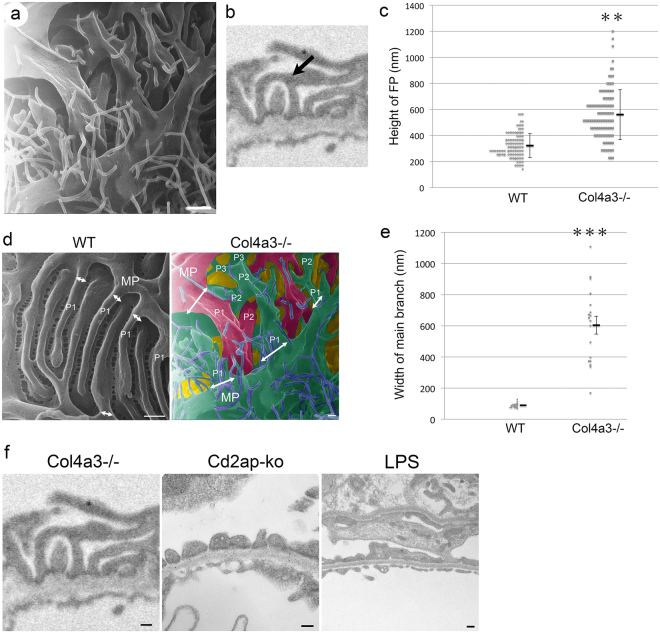Figure 4.
Increased bridging processes in Col4a3−/− glomeruli. (a) Representative image of Col4a3−/− glomeruli shows primary processes giving rise to many “intermediate” processes with more branching formations. These intermediate processes intercross with each other and form “bridge”-like structures between primary and foot processes. Scale bar, 500 nm. (b) Representative image of foot processes of Col4a3−/− glomeruli in TEM. Arrow indicates a bridging foot process. (c) The foot process (FP) height is significantly increased in Col4a3−/− mice (n = 108) compared to wild-type (WT) mice (n = 114) (**p < 0.01 by Student’s t-test). (d) HIM images of podocyte processes in wild-type (WT) (left panel) and Col4a3−/− (right panel) mice. White arrows represent the width of main branch from major processes. Pseudo-colored picture was obtained by processing Fig. 4a in Adobe Photoshop (right panel). The pseudo green color represents podocyte major process and foot processes from a podocyte, and the pseudo red color represents podocyte major process and foot processes from another podocyte. Pseudo purple color represents microprojections originating from podocytes. MP, major processes; P1, main branch from MP; P2, second branch; P3, third branch. Scale bars, 200 nm. (e) The width of main branch from podocyte major processes is significantly increased in Col4a3−/− (n = 18) compared to WT (n = 23) glomeruli (***p < 0.001 by Student’s t-test). (f) Representative TEM images of processes in Col4a3−/− (left panel, copied from Fig. 4b, for comparison), Cd2ap-knockout (ko) and lipopolysaccharide (LPS) treated mice (right panel). While bridging processes are observed in Col4a3−/− glomeruli, diffuse foot process effacement and flattened foot processes are detected without bridging processes in Cd2ap-ko and LPS-treated glomeruli. Scale bars, 200 nm.

